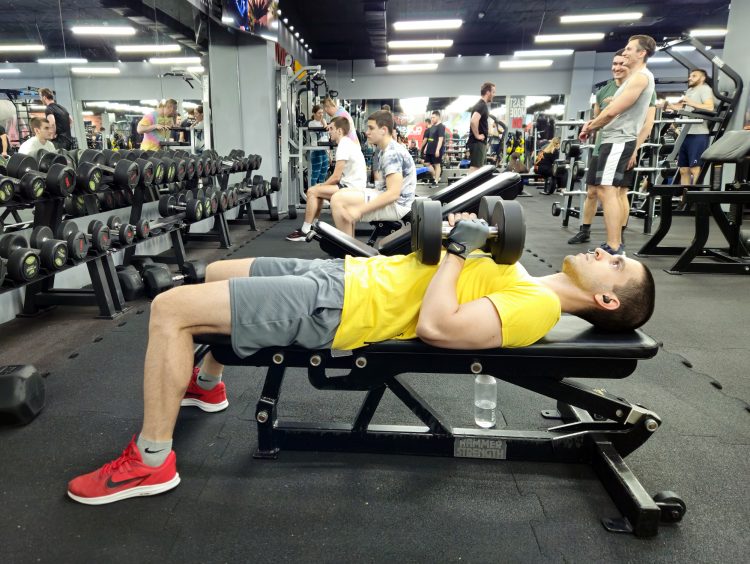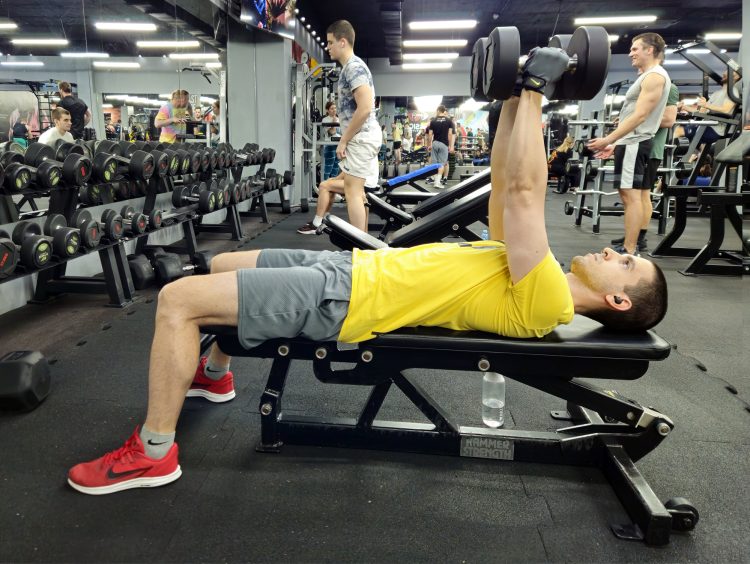Studies have shown that the difference between narrow and wide grips when performing chest press exercises isn’t massive (1). However, it is still significant enough for you to try different pressing variations, including the hex press.
Over my coaching career, I’ve seen people love and hate the hex press, but interestingly enough, none fully understand it. Some say their inner pecs are on fire while performing this exercise, others complain about tricep overstimulation, yet no one is quite sure why.
In this article, I’ll demystify the hex press, break down its movement mechanics, and offer a few alternatives in case you want to diversify your chest workouts.
How To Perform Hex Press
Here’s a step-by-step guide on how to perform the hex press with proper form:
Step One — Choose the Weight
Pick up hexagonal dumbbells of an appropriate weight. You should be able to press these dumbbells for eight to 10 reps, with two or three reps left in the tank. On average, this should be about 60–80% of your one-rep max. (2)
Pro Tip: If you’re training for strength, lift in the 80–100% 1RM range for 3–6 reps.
Level Up Your Fitness: Join our 💪 strong community in Fitness Volt Newsletter. Get daily inspiration, expert-backed workouts, nutrition tips, the latest in strength sports, and the support you need to reach your goals. Subscribe for free!
Step Two — Assume the Starting Position
Sit on a flat bench and place the dumbbells on your thighs. Slowly lie down on the bench and simultaneously kick up the dumbbells using your legs and bring them to your chest level. Hold the dumbbells with a neutral grip (palms facing each other) and press them together over your chest. Plant your feet on the floor under your knees.

Pro Tip: Retract your shoulder blades and push out your chest. This will help ensure a deep chest stretch in the bottom position.
Step Three — Press Up
While pressing the dumbbells together, fully extend your arms above your chest. Hold the isometric contraction for a second at the top of your range of motion.

Pro Tip: Perform quick concentrics to generate maximum force and build strength.
Step Four — Return To Starting Position
Slowly return to the starting position while pressing the dumbbells together. Emply 2–3 second eccentrics to maximize chest fiber stimulation. Hold the fully stretched position for a second. Repeat for recommended reps.
Pro Tip: Keep your elbows tight to the sides throughout the exercise. Flaring the elbows might remove some of the tension from your chest and transfer it to your triceps.
Watch Filip Maric demonstrate how to correctly perform the hex press:
Muscles Worked During Hex Press
Hex press is a compound movement designed to target the inner chest. However, like with any other pressing exercise that targets the chest, other muscles are also used in the movement. The hex press primarily targets:
Chest
The hex press predominantly works your pectoral muscles. However, contrary to popular belief, it doesn’t isolate the inner chest.
This exercise leads to limited inner pec fiber stimulation due to the limited stretch at the bottom. The inner chest does see a massive contraction at the top of the range, but as scientific literature shows us, the fully stretched position is the most conducive to hypertrophy. (3)
Still, the hex press works the chest rather nicely, and it is an excellent exercise for building power and strength. It just isn’t as good for hypertrophy as a regular dumbbell press.
Triceps
Each pressing exercise involves some degree of triceps involvement, and the hex press is no different. The triceps are actively engaged as you extend your arms to press the dumbbells upward.
Shoulders
Front (anterior) delts are, just like triceps, involved in every pressing motion — including the hex press. However, front shoulders aren’t utilized as much during the hex press as they are during the regular dumbbell press.
Jeff Nippard’s Opinion on the Hex Press and Its Effect On Chest Hypertrophy
In his recent video on the best chest exercises, Jeff Nippard (natural bodybuilder and science-based content creator) broke down the hex press and its effects on chest hypertrophy:
“I’m not a big fan of [hex presses]. First, you never get a big stretch in your pecs because your arms never stretch out. They stay tucked the whole time, and they don’t offer maximum tension because your triceps will take over. There’s no evidence that these target the inner pecs. In fact, I think they’d probably be worse for the inner pecks than a standard dumbbell press since the pec fibers aren’t getting as stretched here.”
Get Fitter, FasterLevel Up Your Fitness: Join our 💪 strong community in Fitness Volt Newsletter. Get daily inspiration, expert-backed workouts, nutrition tips, the latest in strength sports, and the support you need to reach your goals. Subscribe for free!
Benefits of Hex Press
While we’ve established that hex press may not be the ideal choice to grow massive inner pecs, that doesn’t mean there’s no place for this exercise in your workout routine. In fact, performing the hex press can be beneficial in the following ways:
Ideal For Those With Shoulder Issues
It’s not a secret that people with shoulder issues struggle with pressing exercises. However, the hex press is an excellent exercise for those with shoulder issues due to a limited stretch at the bottom. It does not put a massive load on your front delts, and most of the heavy lifting will come from the chest and triceps.
Lowers the Risk of Injury
The movement mechanics of the hex press naturally keep your elbows tight to the slides, offering a more “joint-friendly” range of motion than the conventional dumbbell bench press. This alignment reduces the stress on your shoulder joints (mainly the rotator cuff), minimizing the risk of injuries.
Gets You a Great Pump
By actively squeezing the dumbbells together throughout this exercise, you maintain constant tension on your chest muscles, resulting in a notable pump.
Great For Power and Strength
Many pressing exercises, even when performed with limited depth, can effectively build power and strength — whether that’s punching power or functional strength.
Since you’re starting from a less demanding position, you can generate more explosiveness, which trains your fast-twitch fibers responsible for fast, powerful movements.
Common Mistakes During Hex Press
Here are the most common hex press mistakes I’ve seen over the years:
Using Too Much Weight
Avoid ego-lifting to limit the risk of dropping the dumbbells on the sternum and cracking it. To execute hex presses effectively, you must keep the dumbbells pressed together consistently — that is almost impossible if you choose dumbbells that are too heavy for you.
Using Round Dumbells
While you can perform the hex press without the hexagonal dumbbells, I wouldn’t advise you to do so. Round dumbbells won’t stick to one another, and you’ll waste energy trying to keep them in place. They could also slip and move, increasing injury risk.
Not Squeezing Enough
One of the drawbacks of using the hexagonal weights is that you can (kind of) rest them against each other. That somewhat defeats the purpose of the hex press.
You need to continuously press the dumbbells together to maintain the tension in your inner chest — especially at the lockout position when the tension on your chest is at its lowest.
Hex Press Alternatives and Variations
Here are some hex press alternatives and variations you can try:
Plate Press
The plate press is the most common hex press variation. It’s the exact same movement as the hex press, but instead of dumbbells, you press a plate between your palms. The only difference is that you get a slightly smaller stretch at the bottom because the plate prevents you from going as deep as you can with dumbbells.
How To:
- Lie down on the bench and hold the plate between your palms. Keep the plate over your sternum.
- Holding the plate firmly, press the weight straight up until your arms are fully stretched. Pause briefly at the top.
- Slowly bring the plate towards your chest.
- Repeat for 8–10 reps.
Incline Hex Press
The incline hex press shifts the focus to the upper chest. Depending on the incline angle, you will see different levels of upper chest and front delt activation.
How To:
- Set the incline bench to 45 degrees. Sit on the bench with a dumbbell in each hand, resting on your thighs.
- Kick the weights up to your chest as you lay back on the bench. Press the dumbbells together.
- Pull back your shoulder blades and stick your chest up.
- Press the dumbbells at an angle perpendicular to the floor. Hold at the top.
- Control the weight on your way down for 2–3 seconds.
- Repeat for 8–10 reps.
Pro Tip: Don’t press at an angle, as it will move the tension away from your pecs and onto your shoulders.
Diamond Push-Ups
Think of diamond push-ups like reverse hex presses. Instead of pressing the dumbbells, you press yourself up off the floor.
How To:
- Assume a push-up position. Place your hand underneath your sternum and form a diamond shape by touching your thumbs and index fingers.
- Keep your butt up, back straight, and core engaged to stay stable during the movement.
- Slowly descend, keeping the elbows close to your body. Go down as far as you can (until your hands touch the chest).
- Explode back up.
High-to-Low Cable Fly
The high-to-low cable fly is a brilliant inner (and lower) chest-builder and probably the best hex press alternative you can do. It’s performed using a dual-cable machine, with the pulleys set to the highest position. This exercise allows for constant tension, super-deep stretch, and a mighty contraction at the end of the movement.
How To:
- Set the dual-cable machine pulleys to the highest position and attach D-handles.
- Grab the handles with a neutral grip and stand in the middle of the cable machine with your feet shoulder-width apart. Take a step forward.
- Your hands should be at midline in the starting position.
- With your elbows slightly bent, bring the hand down and across your body until your hands meet.
- Slowly return to the starting position.
Wrapping Up
If there’s one thing I’ve learned over my decade-long career, it’s that variety goes a long way. So, try the hex press.
Even if the hex press isn’t your cup of tea, experiment with the alternatives and variations listed in this article to break through plateaus and push further.
References:
- Saeterbakken AH, Mo DA, Scott S, Andersen V. The Effects of Bench Press Variations in Competitive Athletes on Muscle Activity and Performance. J Hum Kinet. 2017 Jun 22;57:61-71. doi: 10.1515/hukin-2017-0047. PMID: 28713459; PMCID: PMC5504579.
- Schoenfeld BJ, Grgic J, Van Every DW, Plotkin DL. Loading Recommendations for Muscle Strength, Hypertrophy, and Local Endurance: A Re-Examination of the Repetition Continuum. Sports (Basel). 2021 Feb 22;9(2):32. doi: 10.3390/sports9020032. PMID: 33671664; PMCID: PMC7927075.
- Pedrosa GF, Simões MG, Figueiredo MOC, Lacerda LT, Schoenfeld BJ, Lima FV, Chagas MH, Diniz RCR. Training in the Initial Range of Motion Promotes Greater Muscle Adaptations Than at Final in the Arm Curl. Sports (Basel). 2023 Feb 6;11(2):39. doi: 10.3390/sports11020039. PMID: 36828324; PMCID: PMC9960616.
Interested in measuring your progress? Check out our strength standards for Bench Press, Push Ups, Cable Fly, and more.








